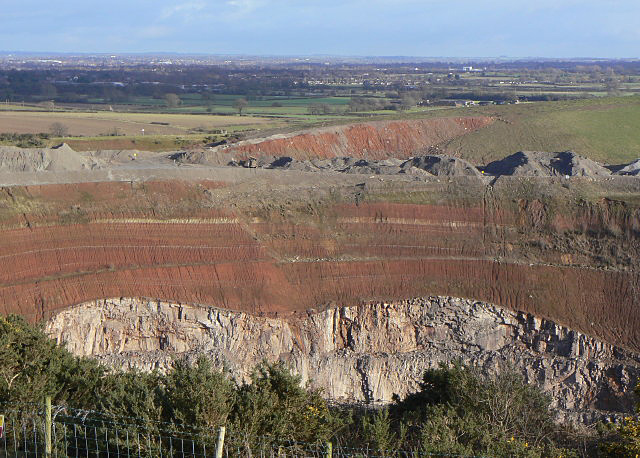Croft Hill and Quarry Walk
![]()
![]() This walk visits the Croft Hill viewpoint and the old Croft Quarry near Leicester. It's a photogoenic spot with fascinating geology and fine views over the area from the hill top. There's no public access to the quarry itself but there are public footpaths heading around the site with fine views down to the quarry workings.
This walk visits the Croft Hill viewpoint and the old Croft Quarry near Leicester. It's a photogoenic spot with fascinating geology and fine views over the area from the hill top. There's no public access to the quarry itself but there are public footpaths heading around the site with fine views down to the quarry workings.
The walk starts in the village and follows footpaths north to the River Soar at Croft Bridge before heading along the western side of the quarry. This will take you up to Croft Hill which stands at a height of 128 metres at the northern end of the quarry. From here there are excellent views over the quarry to the surrounding countryside. You can then pass along a path heading north east towards the neighbouring village of Huncote.
Postcode
LE9 3GP - Please note: Postcode may be approximate for some rural locationsCroft Hill and Quarry Walk Ordnance Survey Map  - view and print off detailed OS map
- view and print off detailed OS map
Croft Hill and Quarry Walk Open Street Map  - view and print off detailed map
- view and print off detailed map
Croft Hill and Quarry Walk OS Map  - Mobile GPS OS Map with Location tracking
- Mobile GPS OS Map with Location tracking
Croft Hill and Quarry Walk Open Street Map  - Mobile GPS Map with Location tracking
- Mobile GPS Map with Location tracking
Pubs/Cafes
Back in the village the 18th century Heathcote Arms is a good choice for some post walk refreshment. They serve good quality home cooked food which you can enjoy in there lovely garden area. You can find them on Hill Street with a postcode of LE9 3EG for your sat navs.
Dog Walking
The walk is a nice one to do with your dog and the Heathcote Arms mentioned above is also dog friendly.
Further Information and Other Local Ideas
You could follow footpaths south west to visit the lakes at Stoney Stanton and more old quarries at Sapcote. The area includes Stoney Cove, a flooded quarry now home to the UK’s National Diving Centre where you can enjoy scuba diving and other activities.
In nearby Sharnford you could also pick up the Leicestershire Round and follow the waymarked circular trail through the county.
A few miles to the north west there's Market Bosworth Country Park where you can visit the historic Bosworth Battlefield. The picturesque Sutton Cheney Wharf on the Ashby Canal can also be explored in this area.
Head west towards Hinckley and there's some good cycling and walking trails to be found on Burbage Common.
For more walking ideas in the area see the Leicestershire Walks page.
Cycle Routes and Walking Routes Nearby
Photos
The quarry can turn out up to 2 million tonnes of granite (granodiorite) per year. It was formed about 500 million years ago from molten igneous materials deep in the earth’s crust. In 1995 planning permission was given to the quarry to take 45 million tonnes of material away. At the current extraction rate this will take over 20 years. When this is done the quarry will be doubled in depth, eventually being 160m below sea level at its deepest point.
View from Croft Hill. Huncote village is in the foreground, Narborough across the middle and Leicester City on the horizon.
On Croft Hill. The final cone of this granite outcrop rises steeply above the surrounding landscape. This is the south-west corner, looking north-west.
3 stages of geological development at the quarry. The rock being quarried is granite, so the lowest levels are relatively early igneous formations. The slightly redder patch just to the right of the strong near-vertical shadow just right of centre shows tightly curved strata (not clearly visible at this scale) indicative of a rising stream of magma. The second stage is the clear evidence of glacial erosion of the granite shown by the smoothly curved boundary between the granite and the overlying sedimentary formations. A noticeable feature of the latter is the way they have been deposited preferentially into the hollows of the underlying granite so that the successive layers show less and less curvature, ending with an essentially horizontal top layer. The sedimentary deposits are mainly red mudstone with some thin intermediate layers of lighter coloured deposits.







